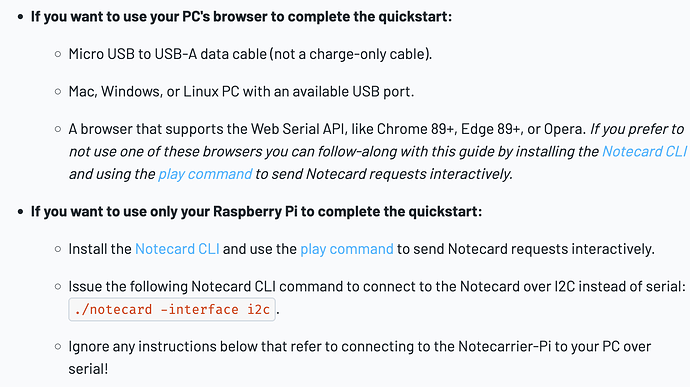I am so confused with the instruction at Quickstart - Blues Wireless Developers. I plug the Notecarrier-Pi into the 40-pin header of my Raspberry Pi, I opened the browser on Raspberry Pi, but it says Unsupported Browser. I downloaded notecard cli and it says error opening serial port: serial device not available. I used a USB cable to connect the notecard to a PC, still not connected.
Hi @sandra,
Sorry to hear about your struggles. It can be a bit of a confusing experience to use the Notecarrier-Pi with a Raspberry Pi…and adding a separate PC just to use the in-browser terminal.
I have a couple suggestions for you though:
-
If you do NOT want to use a separate PC (Mac/Windows/Linux) you can use the Notecard CLI. Instead of communicating with the HAT over serial (as you tried), you can communicate with it over I2C. To do so you just need to issue this command:
./notecard -interface i2c. Then verify connectivity with:./notecard -commtest. -
If you DO want to use the in-browser terminal (provides a really nice experience, especially for the quickstart) you have to use a browser that supports the Web Serial API (unfortunately Chromium on the Pi doesn’t support this yet) on a separate PC. You mentioned connecting a PC via USB, which is great, but I would suggest trying a different cable as you need one that supports data transfers (many cheap cables are charge-only).
Note that of course the Notecarrier-Pi functions on its own without a separate PC. I recommend taking a look at the sensor tutorial and some of our Raspberry Pi example projects on Hackster.
Thanks,
Rob
Thank you for your reply. I am able to connect to the Notecard using I2C now!
@RobLauer I was lucky to continue searching around after getting confused about the same issue as @sandra. So rather than posting a suggestion on how to improve the Notecard Quickstart article.
Let me first propose adding your explanation to @sandra to the Notecard Quickstart article in the proper place.
It might be also helpful to relate the video closer to the text that continues right after this video, which runs by very quickly introducing many new words (different antennas, main “uaf terminal”, etc) resulting with being completely lost after what I hoped to be quick and useful learning. Perhaps a vocabulary of terms covered in that video, with references to say Wikipedia or something else containing more detailed descriptions, would be nice.
I would also offer my own suggestion for enhancements to Notecard Quickstart - but only after I do my best to understand it as well as possible.
Getting in the uninitiated developer’s shoes may not be easy for someone that spent years in the IoT space. However, the key value of your Blues Wireless platform is to enable a lot easier access to developers wearing such shoes ![]()
Hi @adriatic,
This is great feedback and I really appreciate it. It can be difficult to cover what we think are the most critical topics in our quickstart (which is feeling a bit bloated over time!).
In the case of the Raspberry Pi, we did add these instructions to hopefully avoid this confusion:
Always happy to hear more feedback from you as time goes on!
Rob
Thank you @RobLauer for this information. I am planning to spend as much time learning BW as it will take me to be sufficiently proficient to initiate an open source project where RedwoodJS and Blues Wireless project where BW plays a key role in the healthcare domain. I hope to get support from Tom Preston Werner not so much financial (note: open source project) but more political / marketing equivalent.
I am obsessed with the quality of technical documentation - not just accuracy but also being “as easy to understand as possible”. So, you may expect a lot more feedback from me. To make such collaboration easy, please let me know what protocol and format would you prefer (using this “discussion” app is the best).
